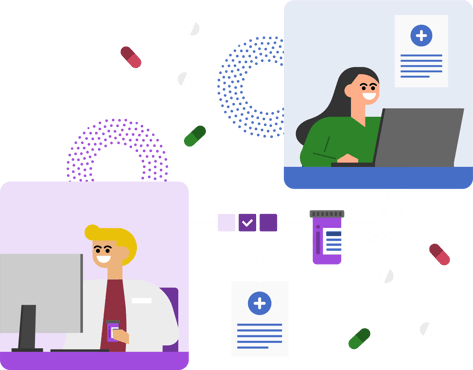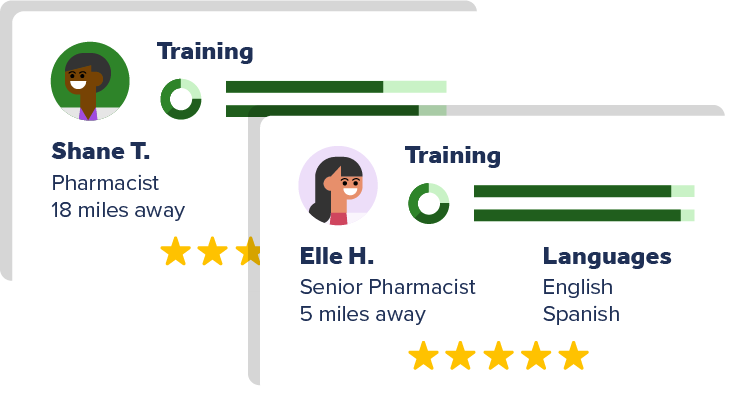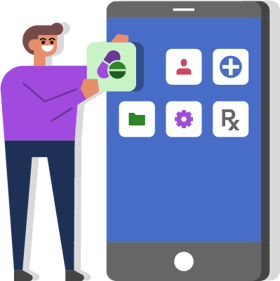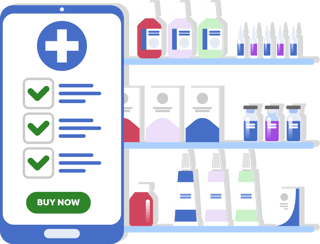Our guide will help you gain a better understanding of the trends, benefits, and future of telepharmacy. Read the guide below or enter your email to download your copy to take on the go.

The future of telehealth and telepharmacy is here. Though both have been evolving for a long time, the COVID-19 pandemic has accelerated the transformation of these healthcare services. A large majority of U.S. consumers now believe telehealth has become "an indispensable part of the healthcare system," according to the results of a survey conducted by The Harris Poll.
Furthermore, nearly two-thirds of consumers said they plan to use telehealth more after the health crisis, and more than three out of every four said COVID-19 has demonstrated a need for more telehealth options. The increased demand for telehealth goes hand in hand with the expansion of telepharmacy. This guide takes an in-depth look at what telepharmacy encompasses, the history of its development, benefits and trends, how to implement a program, and the future of telepharmacy.
The first step is to get a clear grasp of what telepharmacy entails. While more patients are undoubtedly better informed about telehealth today, one can argue that it is still somewhat in its infancy, with most consumers likely lacking a strong understanding of the concept and its associated disciplines, which includes telepharmacy
An article in the American Journal of Medical Research defines telepharmacy as "… the delivery of pharmaceutical care to outpatients at a distance through the use of telecommunication and other advanced technologies." What it actually can deliver is much more than that.
Now it appears that telepharmacy and the other subsets of telehealth are positioned to continue playing a significant role in helping the United States navigate the challenges and uncertainty of the health crisis and then, once the pandemic is behind us, be a mainstay in the delivery of care.

For the success of any telepharmacy program, it’s important that your patients clearly understand what it encompasses and the value and scope of telepharmacy services. Having this understanding helps to yield the kind of patient engagement that’s necessary for achieving desired benefits and outcomes. Let’s start by exploring the various ways telepharmacy can be defined.
The National Association of Boards of Pharmacy's Model Pharmacy Practice Act defines telepharmacy as
“… the provision of pharmacist care by registered pharmacies and pharmacists located within U.S. jurisdictions through the use of telecommunications or other technologies to patients or their agents at distances that are located within U.S. jurisdictions.”
However, there is much more for patients to understand if they are to truly grasp the value and advantages of telepharmacy.
Still, other definitions can expand on this original one. In its statement on telepharmacy, the American Society of Health-System Pharmacists (ASHP) references the Model Act's definition but then goes on to provide its own definition for the purposes of the statement document: "… ASHP defines telepharmacy as a method used in pharmacy practice in which a pharmacist utilizes telecommunications technology to oversee aspects of pharmacy operations or provide patient care services."
An article in Pharmacy Times that defines telepharmacy includes an important caveat about broad definitions of telepharmacy when it states the following:
“Practically speaking, telepharmacy can be defined as the provision of pharmacy services through telecommunication. However, state laws usually define telepharmacy more narrowly, based on pharmacy practice in the states.”
As you can see, the definitions are similar, yet they incorporate slightly different angles. With varying definitions at work, it’s a good idea to plan how you will define telepharmacy to your patients.
When communicating with your patients, we recommend taking a straightforward approach to the definition. For example, you could definite telepharmacy as follows: "Telepharmacy is the use of technology to deliver pharmacy services to patients located at a distance." Some of these services can include comprehensive medication management (CMM), comprehensive medication reviews (CMRs), disease-specific CMM and counseling, and all other medication-related assessments and interventions.
Understanding the delivery of telepharmacy is essential for patients to comprehend the full scope of services. Pharmacists use telecommunications to deliver services; however, the type of telecommunications used can vary from program to program.
It’s important to define the types of technology your practice employs —particularly important if you intend to use technology other than a phone. While patients are generally comfortable speaking on a telephone, they may need to be educated about other audio and video platforms, such as Skype for Business, Microsoft Teams, Zoom for Healthcare, GoToMeeting, and Amazon Chime. In some cases, you’ll need to provide instructions to patients for installation for solutions to ensure the process runs smoothly.
Be sure to also communicate and define the many services that your pharmacists can deliver through telepharmacy, such as:
Drug review and monitoring
Drug information
Medication dispensing
Medication therapy management
Patient assessment and counseling
Compounding medication verification
Decision support
All of this communication goes a long way toward building rapport with your patients.
Patients who are unfamiliar with telepharmacy or have yet to personally participate in a telepharmacy session may have doubts about whether a telepharmacy experience can match that of an in-person experience.

Creating patient trust is an important part of achieving success with your program. When defining telepharmacy, make it clear to patients that your telepharmacy services are provided by registered pharmacists who possess similar training, experience, and knowledge of the professionals they have learned to trust during in-person visits to pharmacies. Consider including photos, bios, and even videos of those pharmacists who will be providing telepharmacy services to create a personal connection between patients and telepharmacists.
Another way to engender patient trust is to highlight the value that can be gained from their participation in telepharmacy. Communicate the fact that pharmacists working in a brick-and-mortar pharmacy only have insights into the prescriptions filled at that pharmacy/chain, which can lead to blind spots in a patient's medication regimen. In contrast, telepharmacists, specifically those leveraging Cureatr's Meds 360°, access a complete view of a patient's medications, irrespective of the filling pharmacy. This information greatly helps a pharmacist optimize a patient's medication regimen and avoid potential adverse events caused by said blind spots.
To round out patient education, it’s wise to give your patients some context of how telepharmacy has evolved over the years.
To better understand where we are today with telepharmacy, it’s wise to take a look back at the history and assess where it stands today.
Did you know that telepharmacy began to take shape as early as 2000? That year the North Dakota State Board of Pharmacy reported that 26 of the state's rural communities had lost their community pharmacies and more were at risk. In response, the board established pilot rules for telepharmacy in 2001 in the hopes that the virtual service could help the state's medically underserved remote rural communities restore and retain pharmacy services.
The following year, the North Dakota State University (NDSU) College of Pharmacy received a federal grant to implement a statewide telepharmacy program and test the new telepharmacy pilot rules. The pilot project proved successful, prompting the state's board of pharmacy to establish permanent rules allowing telepharmacy to be practiced on a broader scale. As NDSU notes,
“These permanent rules allow a retail pharmacy to open and operate in certain remote rural areas of the state without a licensed pharmacist being physically present in the store and allows a pharmacist to supervise a registered pharmacy technician at a remote telepharmacy site using telepharmacy technology for the purposes of dispensing prescriptions to patients, providing drug utilization review, and patient education counseling.”
The study concluded in 2008, NDSU states, with the pharmaceutical industry recognizing that telepharmacy was a safe and effective method for delivering pharmacy services in areas lacking a full-time pharmacist.
This conclusion promoted other states to change or revise their laws to permit telepharmacy, but not all states embraced telepharmacy at that time. In fact, 16 states — or about one in three — did not authorize the use of any telepharmacy or the pursuit of telepharmacy initiatives.
Fast-forward to 2019 and that number had shrunk significantly. Drug Topics reported early in the year that 45 states allowed telepharmacy, but with rules and requirements for operation continuing to vary widely. The future for telepharmacy growth looked "bright," the publication stated. By January 2019 article in The National Law Review noted, “Telepharmacy, while not necessarily a new concept, is beginning to gain more attention in the healthcare industry as a tool to improve patient care and coordination of pharmacy patient care and medication adherence.”
And then, of course, COVID-19 hit.
Though the use of telepharmacy was already on the upswing before 2020, the pandemic certainly punctuated its usefulness. The federal government quickly championed telepharmacy as a way for pharmacists and patients alike to minimize their risk of exposure to the novel coronavirus. As the Centers for Disease Control and Prevention's "Guidance for Pharmacists and Pharmacy Technicians in Community Pharmacies during the COVID-19 Response" online resource notes,
“Pharmacists who are providing patients with chronic disease management services, medication management services, and other services that do not require face-to-face encounters should make every effort to use telephone, telehealth, or telepharmacy strategies.”
To further support telehealth, the U.S. Department of Health and Human Services approved the Coronavirus Preparedness and Response Supplemental Appropriations Act, which removed many of the coverage, licensing laws, and reimbursement barriers that were stifling telehealth. The federal government also helped fund the "COVID-19 Telehealth Toolkit," designed to help organizations implement telehealth during the crisis.
Many states have issued their own public health emergencies that changed Medicaid, private payer, and licensure rules for telehealth as well insurance companies that have made adjustments to telehealth coverage. With this momentum, patients are also getting on board.
A survey of Medicare-eligible seniors by healthinsurance.com found that prior to COVID-19, only about 1 in 10 had used telemedicine. During the pandemic, 44% have used telemedicine, and about the same percentage say they intend on using it after the crisis is over. That's a 340% increase in telemedicine usage among Medicare recipients since the start of health crisis.
While much of the news has focused primarily on usage of the broader concepts of telehealth and telemedicine, telepharmacy has received its own share of attention. In an article in Pharmacy Today, Dr. Sandra Leal, president-elect of the American Pharmacists Association (APhA), states,
“Pharmacists are a great resource for patients who have questions about drug interactions, vaccines, and testing. Telepharmacy allows those conversations to happen in a safer way, with patients located in the comfort of their home, keeping the public and pharmacists safe.”
An article from the American Pharmacists Association (APhA) notes, "Just like telemedicine has been essential during the COVID-19 crisis, the same can be said for telepharmacy."
Patients are increasingly seeking telepharmacy services, which is one of the reasons why we just recently announced that Cureatr was expanding our COVID-19 response program by offering complimentary, virtual medication (i.e., telepharmacy) reviews to primary care practices.
The good news is that telepharmacy has seen increased adoption by organizations, embracing by patients, and greater support on the federal, state, and private payer levels.
Unfortunately, as we previously wrote, federal COVID-19 legislation has yet to grant national provider status to pharmacists. This, we said, constrained their abilities to help in the front-line response to the pandemic. Provider status would add undeniable value during the health crisis, one which concerned delivering telepharmacy services.
We strongly believe telepharmacy's "time is now," but view the lack of provider status as a lingering and substantial barrier to unleashing the potential for telepharmacy to make a significant difference in the fight against COVID-19 and achieving larger improvements in the way we deliver and coordinate care.
To realize the best future for telepharmacy services, the present and potential value for patients and providers must be examined. Let's review six ways telepharmacy is currently adding value for patients in our healthcare delivery system.

Increased Access to Pharmacists – Quite simply, telepharmacy expands access to pharmacy operations and services. These include drug review and monitoring, dispensing, chronic care management, medication therapy management, patient assessment and counseling, clinical consultation, outcomes assessment, decision support, and general medication information.


Expanded Access to Quality of Services – As with other professions, those working in pharmacy services have varying levels of expertise and training or different skill sets, and the skill set a patient may need may not be available at their local pharmacy.
With telepharmacy, a patient can be connected with a pharmacy professional in the best position to support the patient's needs. If a telepharmacist is not a strong fit for a patient, whether due to training or other factors (e.g., language), finding an alternative professional who can better help a patient may prove to be faster and more effective when options are not limited by a physical (brick and mortar) location or timing of a visit to a pharmacy.


More Timely Access to Pharmacists and Services – The time required to travel to and from a pharmacy or wait at the pharmacy for services can be significant for some consumers depending upon where they live and their access to transportation. Finding this time can prove challenging, but with telepharmacy, travel and waiting time is essentially eliminated since there is no need to physically appear at the pharmacy. The only requirement is having access to a phone or Internet connection, if the service will be provided over video. By reducing the amount of time required to receive pharmacy services down to the bare minimum (i.e., the providing and receiving of the services), patients are likely to be more inclined to take advantage of the telepharmacy services available to them.


Reduced Costs – As Patient Engagement HIT notes, "Numerous studies have indicated that drug costs serve as the biggest barrier to medication adherence." When patients need to travel to receive remote pharmacy services, they can incur a wide range of travel-associated expenses, including time off from work. With telepharmacy, the only costs are those associated with the actual services received (assuming that a patient did not purchase a communication device for the purpose of accessing telepharmacy services). As an added bonus, telepharmacy has been shown to deliver significant savings to providers as well.


Improved Satisfaction – A number of studies around telepharmacy come to the same conclusion: patients like it! For example, a study published in the Journal of Pharmacy Technology notes, "Patient assessment of the telepharmacy indicated high degrees of satisfaction with accessibility, service, and patient counseling." This is especially important because, as an article in Health and Quality of Life Outcomes notes, satisfied patients are more likely to comply with treatment; take an active role in their own care; continue using medical care services and stay within a health provider; and maintain a specific system.


Better Health and Outcomes – It’s not surprising that improved access to pharmacists, expanded access to pharmacy services, reduced time and expenses associated with receiving services, and higher satisfaction with services lead to improved health and overall outcomes. This is mainly because telepharmacy ultimately helps address many of the barriers to medication adherence. That's important when one considers that the CDC estimates non-adherence is the cause of 30-50% of chronic disease treatment failures and 125,000 deaths per year in the United States. You can learn more about the benefits of telepharmacy on improvement medication management by watching this Cureatr webinar recording.

As mentioned previously, pharmacists are playing a pivotal role in our nation's response but are being handcuffed because they lack such provider status, thus "preventing them from maximizing their contribution to this battle." Let’s take a moment to survey where things stand concerning national and state-level provider status rules for pharmacists and then discuss four of the ways that granting pharmacists with national provider status — as well as making provider rules universal across states — would add value after the worst of the COVID-19 pandemic is behind us.
There is a push on the federal level to grant pharmacists provider status. This could be accomplished with the passage of "The Pharmacy and Medically Underserved Areas Enhancement Act." As ASCP notes, this legislation that would "… allow pharmacists to practice at the top of their license and bill Medicare Part B for their services." The bill has been introduced in the 114th and 115th Congresses and ASCP stated that it garnered widespread bipartisan support in both houses of Congress.
Unfortunately, as of this writing, the bill remains in limbo despite significant lobbying for it during the health crisis. A dozen pharmacy groups issued a joint statement outlining policy changes they said will allow pharmacists to more effectively support COVID-19 efforts. Among the calls to action: "Immediately include the Pharmacy and Medically Underserved Areas Enhancement Act in emergency legislation to respond to the COVID-19 crisis."
On the state level, where pharmacists are already classified as providers, things are less cut and dry. The state classification is complicated by the fact that exactly what that means varies greatly by state and is determined by matters including wherein the law provider status is granted, pharmacists' scope of practice as described in state law, and the rules on reimbursement.
Explore the question of "What is telepharmacy?" and then touch on a few of the ways the pandemic has accelerated the embracing of this emerging area of care.

The potential gains that telepharmacy may bring to healthcare cannot be overstated. In 2018, an article in Perspectives in Health Information Management, the research journal of the American Health Information Management Association, stated the following: “Telepharmacy may have significant potential to transform the delivery of pharmaceutical services.”
The common types of telepharmacy services that are making the biggest difference include medication therapy management; medication selection, order review, and dispensing; patient counseling and monitoring; drug review/monitoring; verification of oral and sterile compounding; and patient assessment.
Though we discussed benefits of telepharmacy in Chapter One, let’s take a closer look at the top 4 telepharmacy benefits that will matter the most:
“Pharmacists can play a critical role in monitoring medication concerns at the beginning of use, allowing for problem solving, reinforcement, and greater patient satisfaction with and adherence to medication therapy.”
With cost considered one of the most significant drivers of medication non-adherence, the savings achieved by reducing or eliminating travel to a pharmacy can help patients better cover expenses, including those associated with their medications.
Extending Pharmacy Support
Telepharmacy's benefits apply to healthcare providers, not just patients. For example, some hospitals do not offer 24-hour pharmacy services. A 2012 national survey of hospitals conducted by the National Association of Boards of Pharmacy found that roughly one-third of hospital pharmacies lack such coverage. As an Integrated Pharmacy Research and Practice article notes,
“Telepharmacy acts as a potential alternative to around-the-clock on-site pharmacist medication review for remote hospitals. …The emerging electronic health information systems and related technologies, such as fax, and electronic health records make information more readily available to pharmacist for review before a dose is available for administration to a patient. These technologies are advancing telepharmacy services and enabling pharmacist to contribute efficiently in improving medication use.”
Other hospitals provide 24-hour coverage but with reduced staffing during slower hours (e.g., overnight). Then there are those hospitals that maintain consistent 24-hour coverage but do so with a lean staff. Telepharmacy can provide off-hours support to hospitals that take the former approach and can provide surge support or fill in when short staffing occurs for hospitals that take the latter approach.
One area that bears examining is the software improvements that are contributing to increasingly efficient delivery of telepharmacy.
Let's discuss the vital role that software plays in telepharmacy delivery. On a basic level, the delivery of telepharmacy services requires access to an interactive communication platform that enables the use of audio and/or video to connect pharmacists and patients in real time. Some commonly used HIPAA-compliant communication products include Microsoft Teams, Updox, VSee, Zoom for Healthcare, Doxy.me, and Spruce Health Care Messenger.
The good news is that there is a growing number of solutions available. One particular telepharmacy service —medication reconciliation post-discharge (MRP) — is helping pharmacists to better support patients.
Medication reconciliation post-discharge "assesses whether adults 18 years and older who were discharged from an inpatient facility had their medications reconciled within 30 days," according to the National Committee for Quality Assurance. Performing MRP is critical for catching potentially harmful omissions or changes in prescribed medications.
This becomes even more essential for for elderly patients who are typically prescribed a greater quantity and variety of medications. A frequently referenced, peer-reviewed study published in the Drug Safety medical journal revealed that approximately 53% of adults have at least one medication error in their record, 027% of patients suffer an adverse drug reaction post discharge, and 20% of patients are readmitted due to ADEs. Despite these alarming statistics, the study goes on to reveal that only 50-60% of discharged patients receive an MRP, meaning that close to half of all patients are at an elevated risk of experiencing an adverse drug event (ADE) and preventable readmission.
Three of the reasons why MRP is not being performed for all patients are as follows:
Providers are often unaware that a discharge occurred.
Pharmacists, leveraging telepharmacy software like Cureatr's Meds 360°, can play a significant role in better ensuring medication reconciliation post-discharge is performed consistently and correctly.
To understand how a software platform can help a team of telepharmacists improve medication reconciliation post-discharge for our clients' patients, let’s explore how Cureatr's Meds 360° does so:
As a result of more effective medication reconciliation post-discharge, patients can expect fewer harmful adverse drug events, lower readmission rates, and increased quality and patient satisfaction scores.
For further proof as to how telepharmacy can provide substantial benefits, we need look no further than how it has helped (and is helping) to deliver care during the coronavirus pandemic.
As the COVID-19 pandemic unfolded, federal and state governments ramped up their efforts to combat the spread of the disease. As a result, there were a slew of new legal and regulatory developments concerning telehealth. These developments are generally aimed at helping ensure patients can remain at home without jeopardizing their access to critical services. Some of the most significant changes to telehealth services were as follows:
Improved Access to Telehealth Services – In March of 2020, the Centers for Medicare & Medicaid Services greatly broadened access to Medicare telehealth services with the issuing of the 1135 waiver. Under this waiver, Medicare now pays for office, hospital, and other visits furnished via telehealth across the country, including in patient's places of residence (as of March 6, 2020). Additionally, the U.S. Department of Health & Human Services (HHS) Office of Inspector General permitting providers to reduce or waive cost-sharing for telehealth visits paid by federal healthcare programs.

Expansion of State Licensure – In mid-March 2020, HHS announced it was allowing healthcare providers to practice across state lines. This decision was the first step toward removing a significant barrier (at least temporarily) to the continued adoption of telehealth as it indicated that physicians would be permitted to conduct telehealth consults with patients residing in states where those doctors are not licensed. At the time of the announcement, there was no accompanying regulation, but that has since changed. The Centers for Medicare & Medicaid Services (CMS) issued temporary measures allowing providers to practice remote care, even across state lines, through telehealth. Most states have issued some form of a waiver, notes the Federation of State Medical Boards, which is tracking how states are modifying in-state licensure requirements for telehealth in response to the pandemic.


New Patient Eligibility – By the end of March 2020, HHS had waived telehealth requirements in several areas. As the American Society of Health-System Pharmacists (ASHP) noted, this included patient and service eligibility. “Both new and existing patients may now access telehealth for a wide range of services. Previously, telehealth was available for a fairly limited range of services and required that the provider or another practitioner within the provider's practice had provided telehealth services to the patient within the past three years. Now, new patients can receive telehealth services.”


Greater Billing Flexibility – One final noteworthy telehealth law change concerns billing. Also falling under the 1135 waiver, providers can use telecommunication technology to deliver office, hospital visits, and other services to Medicare patients that generally occur in-person and bill for these services at the same level as if they had been provided in person. Providers must use an interactive audio and video telecommunications system permitting real-time communication between the site and patient at home.

These telehealth law changes should be considered if you are thinking about launching a telepharmacy program or growing an existing one. ASHP states that its understanding was that while pharmacists can provide telehealth services "incident to" a Medicare-eligible provider, they cannot yet directly bill Medicare for these services. Unfortunately, this is a missed opportunity to provide further resources in the fight against COVID-19.
While the telehealth legal and regulatory changes are good news for providers and patients, legislators have thus far come up short in addressing what would be a valuable development: granting pharmacists provider status. Despite lobbying by a coalition of pharmacy stakeholders, coronavirus legislation has yet to include pharmacist provider status language.
A letter from Steven Anderson, president and chief executive officer of the National Association of Chain Drug, to members of the federal government and U.S. Congress, argued the following: “Establishing pharmacists as providers in Medicare Part B can further bolster an important access point for care for those afflicted by COVID-19 as well as supplement a national health care system that may be severely overtaxed by the response to the virus. The (HHS) Secretary should authorize that pharmacists be recognized as providers under Medicare Part B subject to state scope of practice laws in order to assist in the response to the COVID-19 outbreak.”
In a recent pharmacy organizations' joint policy statement, they advocate that pharmacists be utilized as frontline responders for COVID-19 patient care. The statement notes that
“Pharmacists are the most accessible healthcare providers and the first touchpoint of patient engagement with the healthcare system. … Pharmacists are trained to treat infectious diseases and can significantly expand access to care if barriers are removed.”
Signatories on this joint statement include the American Pharmacists Association, ASHP, and the American Association of Colleges of Pharmacy. We hope that continued advocacy and lobbying for including pharmacists and their services into future telehealth-related legislation will motivate lawmakers to address what we consider a grave oversight.
At a time when the country has an overstretched workforce and an oversupply of pharmacists, granting provider status to pharmacists and the consequent ability to bill CMS and commercial payers would allow pharmacists to play an even greater role in the effort to end the pandemic.
While there is still much progress that needs to be made by allowing pharmacists to obtain provider status, it’s worth noting that there have been several demonstrated benefits of telepharmacy observed during the recent health crisis. Here are six noteworthy telepharmacy developments and announcements pertaining to the coronavirus pandemic.
In order to maximize such benefits, James Broughel, a senior research fellow at the Mercatus Center at George Mason University explains that because many COVID-19 tests have a relatively long turn-around time and require patients to wait at home for results, it presents opportunities for telepharmacy to fill a vital role. Broughel states that “when results become available, tested individuals could have a consultation with the pharmacist on the phone or via video conferencing platforms such as Skype or Zoom."“With the use of telepharmacy, pharmacists can improve patient access to care, provide credible information and awareness, enable successful comprehensive medication management, provide recommendations for symptom management, and help triage and refer patients to higher levels of care when diagnostic testing is warranted. Telepharmacy has demonstrated value in medication selection, order review, and dispensing; sterile admixture verification; patient counseling and monitoring; and the provision of clinical services.”
“Pharmacists who are providing patients with chronic disease management services, medication management services, and other services that do not require face-to-face encounters should make every effort to use telephone, telehealth, or telepharmacy strategies.”
Many States Are Embracing Telepharmacy
As U.S. Pharmacist notes, a growing number of states have issued waivers or otherwise amended regulations to permit the use of telepharmacy for management of a wide range of pharmacy operations. For example, California permitted pharmacists to remotely conduct order entry and drug-utilization reviews, interpret clinical data, process insurance claims, and perform therapeutic interventions. Also, Minnesota and Nevada have permitted pharmacy staff to process prescriptions and medication orders remotely. Most functions related to prescriptions, besides dispensing, may be conducted remotely. These are just a few examples that illustrate how states can flex in order to allow for increased usage of telepharmacy.
“Allow pharmacists and pharmacy technicians with valid licenses to operate across state lines, including via telehealth. … Authorize pharmacists and pharmacy staff to conduct routine pharmacy tasks remotely as necessary (i.e., prescription data entry and script verification), including those licensed outside the state.”
Chain Drug Stores are Lobbying for Telepharmacy
In a March 2020 letter to U.S. Congressional leadership and the Administration by the head of the National Association of Chain Drug Stores (NACDS), the association pushed for "Immediate federal policymaking [that] would empower pharmacies and pharmacists to help enhance the nation's COVID-19 response right now, and as vaccines and other resources are developed and deployed." Among the recommendations from NACDS: "enabling telepharmacy."
Mercatus Center Executive Director Daniel Rothschild writes,
“To tap into pharmacists' expertise and routine access to patients, states can allow online prescribing, remove restrictions to Clinical Laboratory Improvement Amendments waivers, accept out-of-state pharmacist licenses, or enter into reciprocity agreements with other states, relax restrictions on telepharmacy, and reduce restrictions on pharmacy technicians.”
Rose Abraham, PharmD, Cureatr's New Director of Clinical Pharmacy Operations, has a unique perspective to offer about telepharmacy’s benefits. With her experience overseeing all of the Cureatr’s pharmacy operations, including planning, recruitment, organizing, supervision, and quality assurance activities, Abraham has a front-row seat to understanding the future of telepharmacy and medication management.
She says that COVID-19 has been a game-changer and that as clinicians, pharmacists must learn to adjust to this new normal. Abraham says,
“With telemedicine and telepharmacy, more people can gain access to care they would not have had access to before the health crisis...Unlike a lot of the public perception, pharmacy isn't just dispensing. You now have pharmacies delivering medications, which solves the problem of making sure patients are receiving their medications. Telepharmacy can help with ensuring patients know how to properly take their medications, and you can actually build relationships with patients so they can achieve their goals, which is ultimately the most important benefit,”
Abraham agrees that We need provider status for pharmacists so they can be reimbursed for the many important services they are providing. “It was the right thing to do before COVID-19. It's even more important now...The most significant obstacle standing in their way is lack of reimbursement. It's time to remove that obstacle,” she says.
Taking into account all the ways that telepharmacy can benefit patients during the pandemic and beyond, you may be considering launching a program of your own. If so, there are some important things to keep in mind.
Examine six ways telepharmacy is adding value for patients in our healthcare delivery system.

When considering implementing a telepharmacy program, it’s a good idea to be fully informed. In the interest of clarity, let’s take an objective look at the drawbacks and benefits of pursuing telepharmacy. When you better understand the few drawbacks, you can determine if you can take steps to tackle any obstacles. Equally important is to weigh the many benefits a program can provide. Here are six telepharmacy benefits and drawbacks that you should understand:
Benefit: Expanded access to care
As mentioned previously, telepharmacy can help make healthcare more accessible to those who live in rural or isolated communities and makes pharmacy services more readily available and convenient for those with limited mobility, time, or transportation options.
Drawback: Some Americans still lack broadband access
While not necessary for the delivery of telehealth services, broadband internet greatly improves the speed and convenience, and, in turn, adoption of telepharmacy. Among the benefits of broadband is that it provides a higher speed for data transmission, which is needed for quality videoconferencing and the exchange of large quantities of healthcare information; access is constant, so there's no need to reconnect to the Internet, as is required for dial-up internet; and it does not impede phone lines. Unfortunately, millions of Americans do not have broadband access; however, this is expected to change. As the Federal Communications Commission's latest annual Broadband Deployment Report notes, the number of Americans without access to fixed broadband decreased 30% during 2017 and 2018. In addition to this momentum, lawmakers are also aggressively pushing for the expansion of broadband access.
Benefit: Substantial increase to services and patient satisfaction
Common beneficial services provided via telepharmacy include comprehensive medication management (CMM); medication therapy management (MTM); medication reconciliation post-discharge (MRP); drug information, review, and monitoring; and patient assessment and counseling. These and other telepharmacy services can help patients in a variety of ways, including, improving medication adherence, more timely access to pharmacists, reduced need for emergency care, reduced travel costs, and increased engagement in care.
Drawback: Lack of federal provider status for pharmacists
As previously mentioned, pharmacists currently lack national provider status. Without national provider status, pharmacists, including those filling telepharmacy roles, will need to be more selective of the services they offer and provide to Medicare beneficiaries to better ensure services are covered (i.e., reimbursable). While the lack of national provider status is frustrating and can reduce the benefits of telepharmacy for patients and organizations that offer telepharmacy services, there is a significant effort underway aimed at educating lawmakers about the importance of granting pharmacists provider status. The Patient Access to Pharmacists' Care Coalition (PAPCC) is a multi-stakeholder and interdisciplinary initiative aimed at developing and helping enact a federal policy proposal that would enable Medicare beneficiary access to, and pay for, Medicare Part B services by state-licensed pharmacists in medically underserved communities. In addition, there's bipartisan federal legislation — H.R. 592/S. 109 — that, as PAPCC notes, would "… amend Medicare and increase medically underserved seniors' access to healthcare through pharmacist-provided care."
Benefit: Many benefits for other stakeholders – patients, pharmacies, providers and payers
Strong arguments can be made that telepharmacy helps pharmacies, providers with telepharmacy programs, payers, and the healthcare system as a whole. For example, pharmacies that leverage telepharmacists gain the ability to cost-effectively expand the hours they can provide services to patients without needing to keep the physical pharmacy location open, reach even more patients thanks to these expanded hours, and support more patients since there will be more pharmacists available to deliver services. Provider organizations with telepharmacy programs can provide the aforementioned enhanced convenience for patients; reduce overall costs, decrease readmissions, and drive better outcomes, which are critical to achieving the goals of value-based care; boost their Healthcare Effectiveness Data and Information Set (HEDIS®) and Medicare Star ratings; and improve collaboration across the patient care team, including physicians and specialists. Finally, payers migrating toward value-based care or considering doing so are likely looking for provider organizations to offer programs that help achieve proactive management of patient health and keep patients healthy, while reducing total cost of care — all of which telepharmacy delivers.
Drawback: Inconsistent state rules
Because rules vary from state to state concerning the services pharmacists are permitted to provide and what services are permissible via telehealth, this inconsistency can create a barrier. As Drug Topics notes, "Pharmacists are already classified as providers in most states … But what that means depends on just where in state law pharmacists are classified as providers. It depends on pharmacists' scope of practice under state law. And most importantly, it also depends on what states do or do not require in terms of reimbursement for pharmacist services." When rules lack uniformity, confusion emerges. Organizations launching telepharmacy programs will need to ensure they understand the rules for their state(s) and will also need to put an increased emphasis on patient education concerning available and covered services. Patients who attempt to conduct internet research into telepharmacy services may come away with a misunderstanding of the services available to them.
It's important to note that with each drawback is that there are efforts on the state level to have all states recognize pharmacists as providers, and the push for national provider status should only help with these endeavors. In addition, the appreciation for telehealth has never been higher (thanks to the pandemic), which should serve to motivate the federal government and state governments to loosen unnecessary restrictions on services delivered via telehealth, including telepharmacy.
All of the aforementioned benefits can only be achieved by hiring the best staff to implement your program, so let’s review why talented professionals may want to join a telepharmacy.
As demand for telepharmacy has increased, so has the need for professionals to provide these virtual pharmacy services. The door is open for pharmacists and pharmacy technicians to pursue new opportunities associated with filling the role of a telepharmacist.
Here are six of the reasons why pharmacists and pharmacy technicians should strongly consider becoming telepharmacists.

Telepharmacy is Growing – While recent telepharmacy-specific data is scarce at the moment, we can draw some conclusions about telepharmacy by looking at broader telehealth data. Overall, telehealth claim lines — defined as individual services or procedures listed on insurance claims — increased nearly 3,600% nationally from August 2019 to August 2020, rising from about 0.2% of medical claim lines in August 2019 to 6.1% in August 2020, according to data from FAIR Health. In 2020, 46% of U.S. consumers had used telehealth — an increase from 11% in 2019, reports McKinsey. Pharmacists and pharmacy techs who pursue work as a telepharmacist now may not be getting into the field "on the ground floor," but telepharmacy is clearly just beginning to take off.


Helping Patients – For pharmacy professionals looking to make a difference in the lives of patients, becoming a telepharmacist should prove extremely rewarding. Telepharmacy is a highly efficient and effective way of helping patients, particularly those with reduced access to care (e.g., rural communities) and vulnerable populations. For vulnerable patients, telepharmacists can deliver services without patients needing to leave their homes, which is an especially important benefit as we continue to battle COVID-19. These services also support efforts to provide patients with comprehensive medication management (CMM).


Convenience – While some telepharmacy service providers establish a physical location for their telepharmacists to work out of, others permit their telepharmacists to work remotely, with some caveats. The telepharmacists must be able to provide services and capture patient data in a secure manner. The American Pharmacists Association states, "The same HIPAA requirements exist for healthcare providers, whether they are administering patient care in person or via telehealth. Electronic files need to be stored securely and extra precaution needs to be taken to ensure that … both sides of the telehealth consultation (i.e., both the pharmacist’s and the patient’s environments) are private.” Assuming pharmacists can meet these requirements wherever they intend to provide telepharmacy services, then filling the role of a telepharmacist should be simple and convenient.


Flexibility – Although telepharmacy service providers may expect their telepharmacists to meet some contractual requirements concerning service delivery (e.g., number of hours or patients supported in a week/month), telepharmacists often have flexibility concerning their work schedule. This flexibility also means pharmacists and pharmacy techs may be able to "test out" the experience of working as a telepharmacist for limited hours and then exploring the opportunity to expand their role and/or responsibilities if they find the experience rewarding and worthwhile.


Supplemental Income – Because pharmacy professionals with full-time positions may be able to take on hours before or after their shifts and/or on days off, telepharmacy can be a great way for pharmacists and pharmacy techs to earn supplemental income. Telepharmacy service providers may be looking for pharmacy professionals willing to work short — or sometimes long — shifts throughout the day and night and on all days of the week.


Develop New Skills and Strengthen Existing Skills – While many telepharmacy services are also provided in person, pharmacy professionals may be exposed to new services through their telepharmacy work. For example, statistics show that only 50-60% of patients receive post-discharge medication reconciliation (MRP) despite its proven benefits at averting preventable readmissions. Pharmacists and pharmacy techs that become telepharmacists may find themselves performing MRP for the first time or much more frequently. There is also the matter of learning how to effectively deliver virtual care experiences, so telepharmacists learn how to become better communicators. Video interactions have their own dynamics. Telepharmacists learn how to effectively listen and look into the camera when speaking with a patient and/or caregiver. With more services going virtual, developing or honing these skills will prove valuable in the short and long term.

If you are motivated to pursue work as a telepharmacist, reach out to Cureatr. We are looking for board certified pharmacists and pharmacy techs interested in opportunities to deliver telepharmacy services.
Finding talented professionals is indeed a big piece of the puzzle, but there’s still much to consider before moving to enact a program.
The first steps to take if you are considering launching a telepharmacy program are to evaluate your current environment and identify what to do to develop a telepharmacy system that can support a successful program. Let’s review six key considerations when beginning a program.
Keep in mind that while most states permit some form of telepharmacy, requirements can vary significantly from one location to another. It is advisable to reach out to your state's board of pharmacy and state pharmacy association for information on current regulations. If you hope to deliver telepharmacy services across state lines and/or intend to establish telepharmacy operations in multiple states, you will want to determine the rules for all of these states.
Once you understand the types of telepharmacy services you are permitted to deliver in your state(s), you can begin to research those services and begin to develop the process, policies, and procedures your telepharmacy team will need to follow to best ensure safe and effective delivery. Common telepharmacy services include the following:
Medication therapy management (MTM)
Medication reconciliation post-discharge (MRP)
Drug information, review, and monitoring
Patient assessment and counseling
Compounding medication verification
It's imperative to identify resources available within your organization to determine what will be required for you to create an effective telepharmacy system. Components and resources you will want to evaluate include the following:
Physical space: Do you have existing space that you can house your telepharmacy team, or do you need to acquire that space? What will you need to appropriately furnish the space to deliver services?
Personnel: Do you have pharmacists and pharmacy technicians available to staff the program? As your research into rules may have indicated, some state boards of pharmacy identify specific training, certification, and/or experience pharmacy technicians must possess to legally engage in telepharmacy services. You will also need to identify who will oversee and coordinate the program, handle scheduling, perform billing, etc.
Education and training: Do you have the means to provide and document the education and/or training that will be necessary to get your pharmacists and pharmacy technicians comfortable with delivering telepharmacy services?
Licensing: Do you meet the licensing requirements to deliver telepharmacy? If not, do you know who can research and secure that licensing for you? In addition, if you plan to stock controlled substances, you will need to complete the Drug Enforcement Administration registration process.
Be sure to evaluate your organization's existing infrastructure to determine the types of IT systems and solutions that you will need to implement. These may include the following:
HIPAA-compliant platform(s) to collaborate with other members of patient care teams
Computerized provider order entry system
Pharmacy information system
Telepharmacy software that specifically supports the delivery of telepharmacy services, such as a solution that helps with medication reconciliation post-discharge
Data exchange architecture
An essential consideration when evaluating your IT infrastructure and making any investments to build it out further in support of your telepharmacy program is security. As the American Pharmacists Association notes, "The same HIPAA requirements exist for healthcare providers whether they are administering patient care in person or via telehealth."
Organizations interested in adding telepharmacy have options as to how to do so. For instance, if the evaluation of components, resources, and IT infrastructure demonstrate that most of the nuts and bolts for a program are available and/or already in place, then proceeding with an in-house offering may be feasible and worthwhile.
However, if the evaluation reveals that your organization lacks most components, resources, the IT infrastructure, and, most importantly, the time required to develop a strong telepharmacy system, you can now offload the services to a third party. For example, Cureatr offers a telepharmacy service. We supply health systems and provider organizations with board-certified clinical pharmacists who deliver medication management support services, including patient assessments, medication therapy evaluation, medication care plan development, and follow-up and monitoring. Our telepharmacists use the Meds 360° platform and essentially become an extension of the care team, with care coordinated across providers and settings.
Another less-clear scenario could be that the evaluation reveals that your organization is missing some of the key components, resources, and/or IT needed for a telepharmacy program. Fully outsourcing the service remains an option, as does working to fill in those holes and running an in-house program. If you choose to proceed with the latter, it is paramount that you provide your pharmacists and pharmacy technicians with the software they need to efficiently and safely deliver your telepharmacy services.
For those that choose to go the route of outsourcing your telepharmacy services, here are some of the recommended qualities to look for in a vendor:
All clinical pharmacists are board certified and licensed
Pharmacists have access to software that supports their efforts in delivering comprehensive medication therapy management
You receive detailed reports on services rendered
Scheduling flexibility to meet your organization's needs (e.g., 24/7, weekends, nights, peak hours, leaves of absence, emergency support)
Service flexibility to meet your and patients' needs
You receive information on how the vendor will be best ensuring HIPAA security
Vendor places a high priority on quality assurance and performs regular audits on clinical team performance and outcomes
See the six important steps to help you evaluate your current environment and identify what to do to develop a telepharmacy system that can support a successful program.

The benefits realized by patients and providers from increased use of telepharmacy have only just begun to be realized. And they will not be forgotten after the pandemic. Though we anticipate that at least some of the federal, state, and private payer decisions that eliminated barriers and/or improved access to telepharmacy, during the pandemic will be rolled or scaled back once the worst of the pandemic is behind us, this will only slightly slow the momentum behind virtual care services.
Centers for Medicare & Medicaid Services Administrator Seema Verma told STAT News that she favored keeping in place the expanded telehealth access following the pandemic: "People recognize the value of this, so it seems like it would not be a good thing to force our beneficiaries to go back to in-person visits." As Healthcare IT News notes, a recent Kyruus survey found that about three-quarters of patients who have received virtual care during the pandemic said they want to see it become a standard part of care.
All of this is encouraging, but as long as pharmacists lack federal provider status, telepharmacy will be hampered. Even considering other potential barriers to growth and adoption, such as inconsistent rules from state to state and private payers varying in whether, how, and to what extent they choose to cover telepharmacy services, no obstacle is as significant as pharmacists not being permitted to practice at the top of their license and bill Medicare for their services.
Rose Abraham, PharmD, Cureatr's director of clinical pharmacy operations, sees it this way:
"We need provider status for pharmacists so they can be reimbursed for the many important services they are providing. The pandemic has led to accelerated growth of telemedicine and telepharmacy, and we are seeing the significant benefits of allowing patients to leverage these services. … We have pharmacists who are available and qualified to deliver these critical services virtually. The most significant obstacle standing in their way is lack of reimbursement. It's time to remove that obstacle."
As noted, pharmacists are playing a pivotal role in our nation's response but are being handcuffed because they lack such provider status, thus "preventing them from maximizing their contribution to this battle."
Now let's highlight some of the more significant ways that granting pharmacists with national provider status and eliminating state-level limitations on pharmacist provider status will improve delivery of care following the pandemic.
Granting pharmacists with provider status would help eliminate many of the obstacles hindering telepharmacy while motivating and enhancing the ability of pharmacists to deliver virtual services that can improve patient wellness and access, strengthen care coordination, and reduce costs, among many other benefits."Telepharmacy has demonstrated value in medication selection, order review, and dispensing; sterile admixture verification; patient counseling and monitoring; and the provision of clinical services."
Meds 360° shows everything a patient has been taking for the last 12 months, whether they went through insurance or not, which for Abraham, is a vital component.“As I learned more about Cureatr and Meds 360°, I was impressed not just by the platform, but the data it contained. It's typically very difficult to determine exactly what medications patients take because most see multiple doctors and often use multiple pharmacies to fill prescriptions.”
“With information about medications obtained with and without insurance, you can perform a complete drug utilization review since you are accessing all of the medications a patient is taking, not just some or most of them. When you're missing a piece of the medication history puzzle, you can't fully determine the potential drug interactions a patient may experience. You can only effectively educate the patient based on what you see and what you know.”
If patients had easier and expanded access to vaccines, and received regular education about their importance, vaccination and immunization rates would rise. Granting pharmacists with provider status would help eliminate logistical, financial, and regulatory roadblocks to vaccination that are jeopardizing health and wellness."Although pharmacists in all 50 states have been given the authority to administer influenza vaccines to adult patients, pharmacists in some states are still limited by which vaccines outside of influenza they are able to administer, the age of patients they are able to administer to, and whether a patient needs a prescription before getting a vaccine at the pharmacy."
Considering all of the current and potential benefits of telepharmacy, it’s clear to see that the future looks very bright, even with the obstacles such lack of provider status for pharmacists. Despite this and other challenges, it seems that telepharmacy's day is here — sooner than many expected. And that's great news for patients, healthcare providers, and our healthcare system as a whole. From what’s been prescribed to what’s being picked up — and what’s not. It’s revolutionary for clinicians, but moreover, potentially life-saving for patients. What we are able to do with this platform is changing and will continue to change healthcare for the better.

52% of seniors are comfortable using telehealth services to receive care.

91% reported a favorable experience and 78% rindicated a likelihood to complete a medical appointment via telehealth again.
It is imperative that physicians work to help ensure patients fill their prescriptions and take medications as directed. Learn four steps doctors can follow to support these objectives.
Now that you have a better understanding of some of the more significant telepharmacy benefits and obstacles, you also — hopefully — have a greater appreciation for telepharmacy in general and why launching a program would be worthwhile.
With its ability to provide increased access to pharmacists, expanded quality of services, more timely access to services, reduced costs, improved patient satisfaction, and better health outcomes, telepharmacy is set to become one of the most important aspects of telehealth in the future.
If implementing a program is your next step, it’s time to consider whether you should build a program or buy one. Be sure to research your options available in your state thoroughly and look for a program that can provide beneficial services such as comprehensive medication management (CMM), medication therapy management (MTM), and remote patient monitoring, among others.
Cureatr has revolutionized medication management by bringing together clinical data and medication history in one place with Meds 360. It gives healthcare providers something they’ve never had before: the ability to reliably fill in the blanks of a patient’s medication usage, from what’s been prescribed to what’s being picked up — and what’s not. It’s revolutionary for clinicians, but moreover, potentially life-saving for patients. What we are able to do with this platform is changing and will continue to change healthcare for the better.
If you're interested in learning more about how Cureatr can assist your organization in launching or supporting a telepharmacy program, contact us today to get started. One of our telepharmacy experts will gladly answer your questions about starting a telepharmacy program and how we help organizations add and effectively leverage telepharmacy services.

© Cureatr 2023 | Privacy Policy
HEDIS® is a registered trademark of the National Committee for Quality Assurance (NCQA).